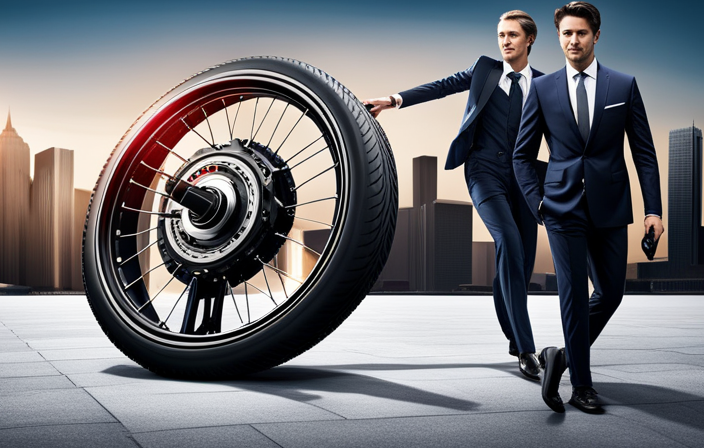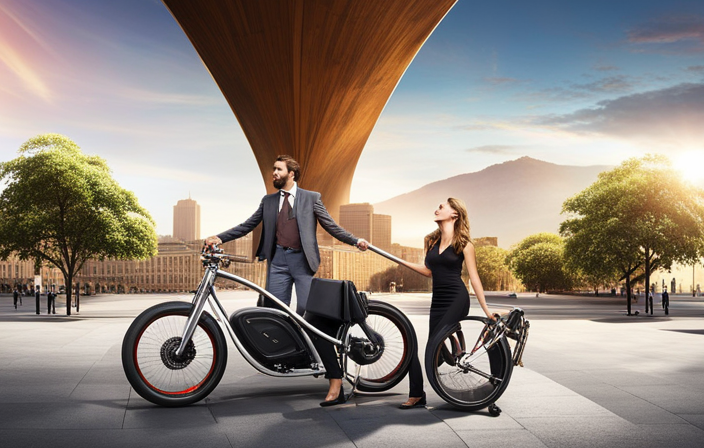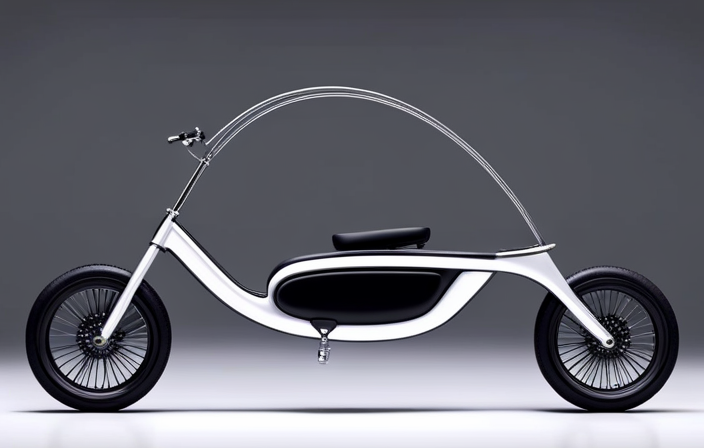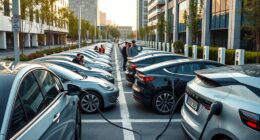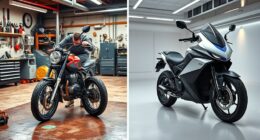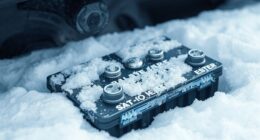As a dedicated electric bike fan, I’ve always been fascinated by the power and efficiency of brushless motors.
But when it comes to choosing the right KV rating for my electric bike, the options can be overwhelming. Fear not, fellow riders!
In this article, we will dissect the intricacies of KV ratings, explore the factors to consider, and provide installation and maintenance tips.
So, let’s dive into the world of KV brushless motors and unleash the full potential of our electric bikes.
Key Takeaways
- KV rating determines motor performance and battery life, with higher KV ratings providing better acceleration and lower KV ratings offering more torque and slower acceleration.
- Low KV motors have advantages such as increased torque, improved efficiency, and extended motor lifespan, but they have reduced top speed and require larger and heavier gear systems.
- High KV motors offer faster acceleration and higher top speeds, making them ideal for flat terrains or velocity, but they sacrifice torque and experience more wear and tear.
- Mid-range KV motors strike a balance between speed and torque, providing versatility, decent top speed, good climbing ability, and a smooth and efficient riding experience.
Understanding KV Ratings
To understand KV ratings, you need to know that it refers to the RPM (rotations per minute) that the motor will turn per volt of electricity applied. This rating is crucial in determining the motor performance and battery life of an electric bike.
The impact of the KV rating on acceleration is significant as well. A higher KV rating means the motor will spin faster with each volt applied, resulting in better acceleration. On the other hand, a lower KV rating will provide more torque but slower acceleration.
It’s important to find the right balance between speed and torque based on your specific needs and preferences. When choosing the right KV motor, factors such as terrain, weight, and desired top speed should be taken into consideration. Ensuring the motor’s KV rating aligns with these factors will guarantee optimal performance for your electric bike.
Factors to Consider in Choosing the Right KV Motor
When choosing the right KV motor for your electric bike, there are a few important factors to consider.
Firstly, think about the power output that you require. This will depend on the weight of your bike and the speed you want to achieve.
Secondly, motor efficiency is crucial as it determines how effectively the motor converts electrical energy into mechanical power. Look for motors with high efficiency ratings to ensure optimal performance and longer battery life.
Lastly, consider the voltage of your battery pack. Different KV motors are designed to work with specific voltage ranges, so it’s important to choose a motor that matches the voltage of your battery.
By considering these factors, you can select the right KV motor for your electric bike that will provide the desired power output and motor efficiency.
Moving on to low KV motors, they have their own advantages and considerations.
Low KV Motors
Consider the advantages and considerations of opting for a low KV option.
A low KV motor refers to a motor with a lower RPM per volt rating. One advantage of using a low KV motor is increased torque. This means that the motor can provide more power to overcome obstacles or carry heavier loads.
Furthermore, low KV motors tend to be more efficient and produce less heat, which can extend the motor’s lifespan. However, there are also disadvantages to using a low KV motor. One major drawback is the reduced top speed compared to high KV motors. Additionally, low KV motors require larger and heavier gear systems to achieve the desired speed, which can impact the overall weight and balance of the electric bike.
Transitioning into the subsequent section about high KV motors, it is important to consider the trade-offs between speed and torque when deciding on the appropriate KV motor for your electric bike.
High KV Motors
If you’re looking for more speed, opting for a high KV option might be the way to go. High KV motors have certain motor specifications that can enhance the performance of your electric bike. Here is a performance comparison between high KV motors and other options:
- Increased RPM: High KV motors have a higher RPM (revolutions per minute), allowing for faster acceleration and higher top speeds.
- Decreased torque: High KV motors sacrifice torque for speed, making them ideal for flat terrains or riders who prioritize velocity over torque.
- Efficient for lightweight riders: High KV motors are better suited for riders with a lighter weight, as they may struggle to generate enough torque for heavier riders.
- Requires higher voltage: High KV motors typically require higher voltage batteries to maximize their performance potential.
- Increased wear and tear: Due to the higher RPM, high KV motors tend to experience more wear and tear than lower KV options.
Transitioning into the subsequent section about ‘mid-range kv motors’, it’s important to consider the trade-offs between speed and torque in motor selection.
Mid-range KV Motors
Transitioning to mid-range KV motors, riders can find a balance between speed and torque for their electric bikes.
Mid-range KV motors offer a performance that falls between high and low KV motors, making them versatile for various riding styles.
With a mid-range KV motor, riders can enjoy both decent top speed and good climbing ability. These motors provide a good compromise between the high speed offered by high KV motors and the torque provided by low KV motors.
The benefits of mid-range KV motors lie in their ability to deliver a smooth and efficient riding experience, while still allowing for quick acceleration and decent hill climbing capabilities.
As we move into the next section, we will explore the power versus efficiency trade-off in more detail.
Power vs Efficiency Trade-off
When it comes to choosing a motor for your application, understanding the relationship between KV (RPM per volt) and performance is crucial.
High KV motors are preferred for speed, as they offer higher RPMs and faster acceleration.
On the other hand, low KV motors are favored for torque, providing more power for tasks that require strength and pulling capacity.
However, finding the right balance between speed and torque is essential for optimal performance, as too much of either can lead to inefficiency and potential motor damage.
High KV motors for speed
Using high KV motors can greatly increase the speed of your electric bike. When it comes to motor power requirements, opting for high KV motors allows for higher RPMs, resulting in increased speed. This is because KV, or kilovolt, rating represents the number of RPMs per volt supplied to the motor.
By choosing a high KV motor, you can optimize the motor’s performance and achieve higher speeds. However, it’s important to note that high KV motors may require a higher voltage battery to operate efficiently. Therefore, when selecting a high KV motor, it is crucial to consider the battery voltage and capacity to ensure compatibility and avoid any potential performance issues.
Transitioning into the next section about low KV motors for torque, it is essential to understand the trade-off between speed and torque in electric bike motors.
Low KV motors for torque
Opting for low KV motors allows for increased torque, which is beneficial for applications that require more power and strength. When comparing low KV motors to high KV motors, it’s important to consider the advantages of low KV motors. The table below highlights some key differences between the two:
| Low KV Motors | High KV Motors |
|---|---|
| More torque | More speed |
| Higher efficiency | Lower efficiency |
| Longer battery life | Shorter battery life |
| Better for climbing hills | Better for flat terrain |
| Suitable for heavy loads | Suitable for lightweight applications |
Low KV motors excel in providing higher torque, making them ideal for applications that require more power and strength. They offer better efficiency, resulting in longer battery life and improved overall performance. Additionally, low KV motors are better suited for climbing hills and carrying heavy loads. However, they may sacrifice some speed compared to high KV motors. Finding the right balance between torque and speed is crucial in choosing the optimal motor for your specific electric bike application.
Finding the right balance
To find the right balance, you should consider the specific power and speed requirements of your application. When choosing a brushless motor for your electric bike, it’s important to understand the trade-off between power and efficiency.
Higher power motors may provide more speed, but they can also consume more energy and be less efficient. On the other hand, lower power motors can be more efficient but may not provide the desired speed.
Noise reduction techniques, such as using high-quality bearings and optimizing the motor design, can help improve efficiency and reduce unwanted noise. By finding the optimal balance between power and efficiency, you can ensure your electric bike performs optimally while minimizing noise.
Considering compatibility with controllers and batteries is the next crucial step in selecting the right brushless motor for your electric bike.
Compatibility with Controllers and Batteries
The motor’s compatibility with controllers and batteries is crucial for optimal performance. When choosing a brushless motor for an electric bike, it is important to consider its compatibility with the controller and battery. The motor must be able to communicate effectively with the controller to ensure smooth operation and precise control.
Additionally, the motor should be compatible with the battery’s voltage and current ratings to ensure efficient power delivery. Mismatched compatibility can lead to reduced performance, overheating, or even damage to the motor, controller, or battery. Therefore, it is essential to carefully research and select a motor that is compatible with both the controller and battery to achieve the best possible performance and longevity.
Moving on to motor cooling and heat dissipation, it is important to address the issue of temperature regulation to maintain optimal performance.
Motor Cooling and Heat Dissipation
As a technical expert in the field of electric motors, I understand the importance of cooling in high KV motors. High KV motors generate more heat due to increased RPM, and proper cooling is crucial to maintain optimal performance and prevent overheating.
When considering cooling options, factors such as airflow, heat sinks, and liquid cooling systems must be carefully evaluated to ensure efficient heat dissipation and prolonged motor lifespan.
Importance of cooling in high KV motors
Cooling is crucial in high KV motors to prevent overheating and ensure optimal performance. Motor cooling techniques have a significant impact on motor performance, as excessive heat can lead to decreased efficiency and even motor failure. To better understand the importance of cooling, let’s take a look at the table below:
| Cooling Technique | Impact on Motor Performance |
|---|---|
| Air cooling | Adequate for low KV motors, but may not provide sufficient cooling for high KV motors. |
| Liquid cooling | More effective in dissipating heat, suitable for high KV motors that generate significant heat. |
| Heat sinks | Additional cooling mechanism, used in conjunction with air or liquid cooling, to further enhance heat dissipation. |
Cooling options and considerations
To optimize the performance and reliability of high KV motors, it’s important to explore different cooling options and consider their effectiveness in dissipating heat. Motor cooling techniques play a crucial role in maintaining optimal performance and preventing damage caused by excessive heat.
Here are four considerations when it comes to motor cooling:
-
Air cooling: This method relies on airflow to remove heat from the motor. It can be achieved through natural convection or forced air cooling using fans.
-
Liquid cooling: In this technique, a liquid coolant is circulated around the motor to absorb and carry away heat. It is an effective cooling solution for high-performance motors.
-
Heat sinks: Heat sinks are passive cooling devices that absorb and dissipate heat from the motor. They increase the surface area available for heat transfer and can be combined with other cooling methods.
-
Thermal greases and insulators: These substances help improve heat transfer between the motor and cooling components, ensuring efficient cooling and minimizing heat buildup.
Understanding the impact of heat on motor performance and implementing effective cooling techniques is essential for maximizing motor efficiency and longevity.
Moving on to the next topic of noise and vibration…
Noise and Vibration
You may notice less noise and vibration with a higher kV brushless motor for your electric bike. This improvement in motor performance can have a significant impact on battery life.
When the motor runs smoothly and efficiently, it puts less strain on the battery, allowing it to last longer and provide a greater range. The higher kV rating indicates that the motor has a higher rotational speed, which can result in a quieter and smoother operation.
The reduction in noise and vibration not only improves the overall riding experience but also enhances the longevity of the motor and other components.
However, it is important to consider other factors such as cost and budget considerations when choosing the right motor for your electric bike.
Cost and Budget Considerations
When considering cost and budget for your electric bike, it’s important to weigh the long-term benefits and potential savings of investing in a higher kV brushless motor. The motor power requirements of your electric bike play a significant role in determining the overall cost.
Here are two key factors to consider in your long term cost analysis:
-
Efficiency: A higher kV brushless motor offers improved efficiency, which means you can potentially save on energy consumption and extend the battery life of your electric bike.
-
Maintenance: Higher quality brushless motors tend to require less maintenance, resulting in lower long-term costs.
By investing in a higher kV brushless motor, you can achieve better efficiency and reduce maintenance expenses, ultimately saving you money in the long run.
Now, let’s delve into user reviews and recommendations for further insights.
User Reviews and Recommendations
Looking for insights on user experiences and recommendations?
As a technical enthusiast, I have extensively researched and analyzed various user reviews and recommendations for kv brushless motors for electric bikes. These user experiences provide valuable insights into the performance comparisons among different motors.
Many users emphasized the importance of selecting a motor that offers smooth acceleration and consistent power delivery, resulting in a comfortable and enjoyable riding experience. Some users also highlighted the significance of torque and top speed in determining the overall performance of the motor.
By considering these user experiences and performance comparisons, you can make an informed decision when choosing a kv brushless motor for your electric bike.
Now, let’s delve into the next section to explore some installation and maintenance tips for these motors.
Installation and Maintenance Tips
When it comes to installing a kv brushless motor for an electric bike, it is crucial to follow proper installation techniques to ensure optimal performance and safety.
This includes securely fastening the motor to the bike frame, correctly connecting the wires, and properly aligning the motor with the drivetrain.
Routine maintenance is also essential in order to keep the motor running smoothly and prolong its lifespan. This involves regularly inspecting and cleaning the motor, checking for any loose or worn parts, and lubricating the moving components.
In case of any issues or malfunctions, troubleshooting techniques should be employed to identify and resolve the problem promptly, ensuring minimal downtime and maximum efficiency.
Proper installation techniques
To properly install your kv brushless motor on your electric bike, make sure to follow these techniques.
First, ensure that you have all the necessary tools and equipment, such as a torque wrench, Allen keys, and cable ties.
Begin by removing the old motor, taking care to disconnect all wires properly.
Next, carefully align the new motor with the mounting brackets and secure it tightly using the appropriate bolts.
Double-check that all connections are secure and that there are no loose wires.
One common mistake to avoid is over-tightening the bolts, as this can damage the motor or frame.
Additionally, make sure to route the cables neatly and avoid any potential areas of friction or interference.
By following these installation tips and avoiding common mistakes, you can ensure a smooth and successful installation of your kv brushless motor on your electric bike.
When it comes to routine maintenance and troubleshooting, it is essential to regularly inspect the motor for any signs of wear or damage.
Additionally, check the tightness of the bolts and connections to prevent any potential issues.
If you encounter any problems with the motor, such as unusual noises or a decrease in performance, consult the manufacturer’s manual or seek professional assistance.
Regularly cleaning the motor and ensuring it is free from any debris or dirt will help prolong its lifespan.
Routine maintenance and troubleshooting
After properly installing the brushless motor on my electric bike, I quickly realized the importance of routine maintenance and troubleshooting. Regularly maintaining and troubleshooting the motor ensures its optimal performance and longevity. Here are some important maintenance tips and troubleshooting techniques that I have learned:
- Regularly clean the motor to remove dirt and debris that can affect its efficiency.
- Check the motor’s wires and connectors for any signs of wear or damage.
- Lubricate the motor bearings to minimize friction and prevent overheating.
When it comes to troubleshooting, here are a few techniques that have helped me diagnose and resolve motor issues:
- Check the motor’s connections and ensure they are secure.
- Inspect the motor for any physical damage or signs of overheating.
- Test the motor’s performance using a multimeter to identify any electrical faults.
By following these motor troubleshooting and maintenance tips, you can keep your electric bike running smoothly and avoid any unexpected issues.
Now, let’s move on to discussing some important safety considerations when working with electric bike motors.
Safety Considerations
One important safety consideration is ensuring that the kv brushless motor for the electric bike is properly installed and secured. This ensures optimal performance and reduces the risk of accidents or damage.
When choosing a motor, it is crucial to consider motor power and battery compatibility. The motor power should be suitable for your specific needs, taking into account factors such as terrain and desired speed. Additionally, the motor should be compatible with the battery you are using, ensuring efficient power transfer and preventing any potential issues.
To further enhance safety, it is recommended to regularly inspect the motor and its components for any signs of wear or damage. By following these safety considerations, you can enjoy a smooth and secure ride on your electric bike.
Transitioning into the subsequent section about upgrading existing electric bikes, it is important to consider the various options available to enhance the performance and functionality of your current bike.
Upgrading Existing Electric Bikes
When upgrading your existing electric bike, you should consider the various options available to improve its performance and functionality.
One important aspect to consider is motor compatibility. Before making any upgrades, ensure that the new motor you choose is compatible with your bike’s existing components, such as the battery and controller. This will ensure optimal performance and avoid any potential issues.
In addition to motor compatibility, there are several performance upgrades that you can consider. Upgrading the battery can increase the range and power of your electric bike, while upgrading the controller can improve its responsiveness and efficiency.
Other upgrades to consider include upgrading the brakes, suspension, and tires for enhanced safety and comfort. However, it is important to seek expert advice before making any modifications to your electric bike, as they can impact its overall performance and safety.
Seek Expert Advice
When it comes to seeking advice on electric bikes, it is crucial to consult professionals and experienced riders. They possess the knowledge and expertise to provide valuable insights and recommendations based on their firsthand experiences.
Consulting professionals and experienced riders
If you want reliable advice on what KV brushless motor to choose for your electric bike, consulting professionals and experienced riders can provide valuable insights.
These individuals possess a wealth of knowledge and experience in the field of electric bikes, and they can offer guidance based on their firsthand experiences.
When consulting professionals and experienced riders, it is important to discuss your specific requirements regarding motor power and battery range.
These factors play a crucial role in determining the performance and efficiency of your electric bike.
By sharing your needs and preferences with these experts, they can provide tailored recommendations that are best suited for your particular situation.
Their expertise can help you make an informed decision and ensure that you select a KV brushless motor that meets your expectations.
Getting personalized recommendations based on your specific needs
To receive personalized recommendations based on your specific needs, it’s essential to discuss your requirements with professionals and experienced riders. Here are three reasons why seeking expert advice is crucial when choosing the right KV brushless motor for your electric bike:
-
Optimal Performance: Professionals and experienced riders can consider factors such as your desired speed, torque requirements, and battery capacity to recommend the ideal KV rating for your motor. This ensures that you get the best performance and efficiency from your electric bike.
-
Compatibility: Different electric bike models have varying specifications and components. By consulting experts, you can ensure that the KV brushless motor you choose is compatible with your bike’s frame, drivetrain, and electrical system. This prevents any potential issues and ensures a seamless integration.
-
Safety and Durability: Expert advice can help you select a KV brushless motor that can handle the demands of your riding style and terrain. They can recommend motors with the right power output and cooling capabilities, ensuring the longevity and safety of your electric bike.
Frequently Asked Questions
How do I determine the ideal KV rating for my specific electric bike needs?
To determine the ideal kv rating for my specific electric bike needs, I would consider factors such as desired speed, terrain, and load capacity. Analyzing these variables will help in choosing the ideal motor for optimal performance.
Can I use a low KV motor for an off-road electric bike?
Using a low kv motor for an off-road electric bike can be risky. The ideal kv rating depends on your specific needs, but using a high kv motor can lead to overheating and reduced torque, compromising performance and durability.
What are the potential risks of using a high KV motor on my electric bike?
Using a high kv motor on an electric bike can pose potential dangers, such as increased speed and reduced torque control. Additionally, it can have a negative impact on battery life due to increased power consumption.
How can I ensure proper heat dissipation for my chosen KV motor?
To ensure proper heat dissipation for a chosen kv motor, cooling techniques and thermal management strategies are essential. These include using heat sinks, fans, and adequate ventilation. It’s crucial to maintain optimal operating temperatures to avoid motor damage.
Are there any safety precautions I should take when upgrading my existing electric bike with a new KV motor?
When upgrading an electric bike with a new motor, it is important to take safety precautions. This includes ensuring proper installation and wiring, using appropriate protective gear, and testing the bike in a controlled environment before riding.
Conclusion
In conclusion, choosing the right KV brushless motor for your electric bike is crucial for optimum performance.
Low KV motors provide better torque and efficiency, while high KV motors offer higher speeds.
However, it is the mid-range KV motors that strike the perfect balance between power and speed.
Remember to seek expert advice and consider safety measures during installation and maintenance.
And if you’re looking to upgrade your existing electric bike, make sure to carefully evaluate the KV rating to enhance your riding experience.
